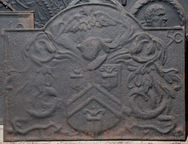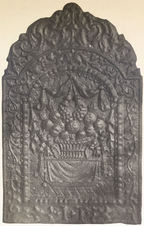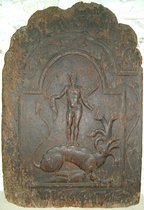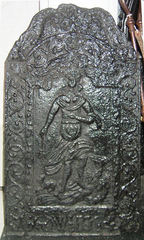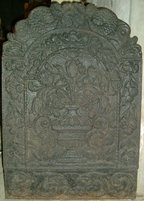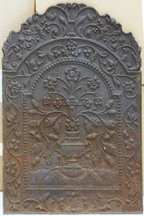-
459
Description: Arched rectangular shape; fillet edging; shield, helm, crest and mantling of the Worshipful Company of Blacksmiths; date in top corners; initials at bottom, below mantling.
Notes: One of the hooked ‘1’ series; unevenly impressed, the right more deeply than the left.
Copies of this fireback are known.
Inscription: 16 50 / I M
Arms: Worshipful Company of Blacksmiths
- Decoration tags:
- rectangular with round arch (shape)
- fillet (edging)
- whole carved pattern
- armorial
- text
Manufactured: in 1650 possibly at Brede Furnace in the Weald area of England.
Current location: Anne of Cleves House, Southover High Street, Lewes, East Sussex, England.
Museum number: 1933.34.046 (part of the Sussex Archaeological Society museum group)
Citation: Dawson, C., 1903, 'Sussex Iron Work and Pottery', Sussex Archaeological Collections, 46, pp. 1-54.
Citation: Gardner, J. S., 1898, 'Iron Casting in the Weald', Archaeologia, 56, 1, pp. 133-164.
- Attached to series:
- Livery company firebacks
- Hooked '1' series
- Brede group
- IM series
-
1049
Description: Arched rectangular central panel with alternate two-bead and pellet edging; table with draped cloth surmounted by a basket containing fruit, swagged drapery above; arched rectangular border with fillet edging; descending vine with leaves and berries; bottom centre, initials separated by a lozenge; on top, symmetrical swirled foliage.
Notes: Typical pastiche of the 'Dutch' style of fireback produced with the option to affix it to a basket grate. The basket of fruit was probably inspired by still-life paintings by European artists of the first half of the 17th century. Formerly part of the J. H. Every collection.
Inscription: I T
Manufactured: in the early-18th century in England.
Current location: Anne of Cleves House, Southover High Street, Lewes, East Sussex, England.
Museum number: 1944.24.082 (part of the Sussex Archaeological Society museum group)
- Attached to series:
- British 'Dutch' style firebacks
- Fruit basket firebacks
-
927
Description: Carved wooden fireback pattern. Arched rectangular central panel, astragal and fillet edge, pictorial, Hercules, sword in hand, preparing to slay the Hydra; arched rectangular border, fillet edge, ivy leaves and tendrils, monogram at bottom; swirled foliage on top.
Notes: Unusually for a pattern, it was carved from a single piece of wood; formerly in the custody of William Hobday (d. 1883), last surviving ironworker at Ashburnham furnace, this pattern was given to the Sussex Archaeological Society by the Revd. J. Bickersteth.
Inscription: TAN
- Decoration tags:
- 'Dutch' (shape)
- fillet (edging)
- whole carved pattern
- pictorial
- mythological
- text
- animals
- humans
Manufactured: in the early-18th century in England.
Current location: Anne of Cleves House, Southover High Street, Lewes, East Sussex, England.
(part of the Sussex Archaeological Society museum group)
Citation: Dawson, C., 1903, 'Sussex Iron Work and Pottery', Sussex Archaeological Collections, 46, pp. 1-54.
- Attached to series:
- Patterns
- TAN series
-
928
Description: Carved wooden fireback pattern. Arched rectangular central panel with astragal and fillet edging; Phaëton riding Apollo’s chariot across the skies, the sun to the left behind clouds, a lion on ground below, between two trees; arched rectangular border with fillet edging; trailing convolvulus leaves surround the central panel.
Notes: The illustration upon which the design has been based has not been identified, save that it figures in book II of Ovid's Metamorphoses. The convolvulus border is a common feature of this series of firebacks; given to the Sussex Archaeological Society by the Rev. J. Bickersteth.
- Decoration tags:
- 'Dutch' (shape)
- fillet (edging)
- whole carved pattern
- planklines
- pictorial
- mythological
- animals
- humans
- objects
Manufactured: in the early-18th century in England.
Current location: Anne of Cleves House, Southover High Street, Lewes, East Sussex, England.
(part of the Sussex Archaeological Society museum group)
Citation: Baines, J. M., 1958, Wealden Firebacks (Hastings Museum).
Citation: Dawson, C., 1903, 'Sussex Iron Work and Pottery', Sussex Archaeological Collections, 46, pp. 1-54.
- Attached to series:
- Patterns
- TAN series
-
975
 ? x ? mmImage subject to copyright
? x ? mmImage subject to copyrightDescription: Arched shape; double-fillet edged arched border, with six evenly-spaced roses, resting on pilasters; shield, supporters, garter and coronet of the Earl of Exeter; plain rectangular bottom panel.
Notes: The arms are of the earldom of Exeter, which was created in 1605 for Thomas Cecil, 2nd Lord Burghley (1542-1623).
Inscription: HONY SOIT QVI MAL Y PENSE [illegible]
Arms: Cecil, Earls of Exeter
- Decoration tags:
- rounded arched (shape)
- fillet (edging)
- whole carved pattern
- armorial
Manufactured: in the early-17th century in Wales.
Current location: Plas Llanmihangel, Llanmihangel, Glamorgan, Wales.
Museum number: GL 7628 (part of the National Monuments Record of Wales museum group)
- Attached to series:
- Personal armorial firebacks
-
1005
Description: Arched rectangular central panel within double fillet foliate edging; pictorial scene of a crudely modelled clothed female figure holding a wand? in the right hand; indistinct pictorial element to bottom right; arched rectangular border with fillet edging containing repeated swirled decoration; on top, two mirrored sea monsters.
Notes: A crude pastiche of the 'Dutch' style of fireback; the central figure may be Hera with a peacock. Formerly at the Raleigh Trevelyan estate, St Cadix, Cornwall.
Inscription: WHC[?]
- Decoration tags:
- 'Dutch' (shape)
- fillet (edging)
- whole carved pattern
- pictorial
- mythological
- text
- animals
- humans
Manufactured: in the early-18th century in England.
Current location: Deja Vu Antiques, 31 Fore Street, Lostwithiel, Cornwall, England.
- Attached to series:
- British 'Dutch' style firebacks
-
476
Description: Arched rectangular central panel with bead edging; pictorial scene of a stork dipping its beak into a tall pot, a fox close by, a tree to the right; arched rectangular border with fillet edging; at top, a double clasp with descending ribbon on each side from which are suspended, via rings, a shield, trumpets and an armoured torso; at the bottom, an oval cartouche between two blocks; on the top, a central pomegranate between two descending sea serpents, and a pomegranate on each shoulder of the plate.
Notes: The scene illustrates one of Aesop's Fables.
- Decoration tags:
- 'Dutch' (shape)
- fillet (edging)
- whole carved pattern
- pictorial
- mythological
- animals
- objects
Manufactured: in the mid- to late-17th century in the Siegerland area of Germany.
Current location: Maidstone Museum, St Faith's Street, Maidstone, Kent, England.
(part of the Maidstone Museum museum group)
- Attached to series:
- 'Dutch' Miscellaneous Firebacks
-
478
Description: Quasi-arched rectangular shape; fillett edging; vertical stylised seed pods contra-scrolled at each end, flanking central pictorial scene of young Jupiter in front of clouds and sunbeams, above young Mars firing a cannon; above, three roses suspended from swirls flanking a basket of flowers; on each side a foliate scroll with a flower bud resting on each; at the bottom, a separate panel with symmetrical swirled foliage.
Notes: One of a small series of firebacks with similar borders.
- Decoration tags:
- rectangular with ornate arch (shape)
- fillet (edging)
- whole carved pattern
- pictorial
- mythological
- humans
- objects
Manufactured: in the early-18th century in England.
Current location: Maidstone Museum, St Faith's Street, Maidstone, Kent, England.
(part of the Maidstone Museum museum group)
- Attached to series:
- Late pictorial series (all)
- Late pictorial series 1
-
479
Description: Arched rectangular central panel with bead-and-pellet edging; on a ground between two plants, a gadrooned flower vase with two, scrolled handles, tulips and other flowers issuing from the narrow neck; arched rectangular border with fillet edging; mirrored descending flower swags; along a rectangular bottom panel with fillet edging a symmetrical arrangement of swirled foliage; on top, two mirrored sea serpents.
Notes: The presence of tulips suggest a Dutch origin for the pattern of this fireback, although the presence of several examples in England suggest that it was produced here rather than on the Continent.
Copies of this fireback are known.
Manufactured: in the late-17th century in England.
Current location: Maidstone Museum, St Faith's Street, Maidstone, Kent, England.
(part of the Maidstone Museum museum group)
- Attached to series:
- Flower Vase 'Dutch' types
- British 'Dutch' style firebacks
-
1170
Description: Arched rectangular central panel with bead on broad fillet edging; two-handled vase standing on a ground, with flowers and oak fronds issuing therefrom in a symmetrical display; arched rectangular border with fillet edging; symmetrical undulating vine with flowers and leaves descending from a trio of flowers; at the bottom, the letter W in a cartouche between swirled foliage; on top, mirrored swirled foliage issuing upwards from a mythical creature on each shoulder.
Notes: The floral theme and its execution shows parallels with the SHR, N and 1724 series of firebacks and could be from the same workshop. The 'W' initial probably denotes the pattern maker.
Inscription: W
Manufactured: in the late-17th to early-18th century in England.
Current location: not known.
- Attached to series:
- W series
- British 'Dutch' style firebacks
